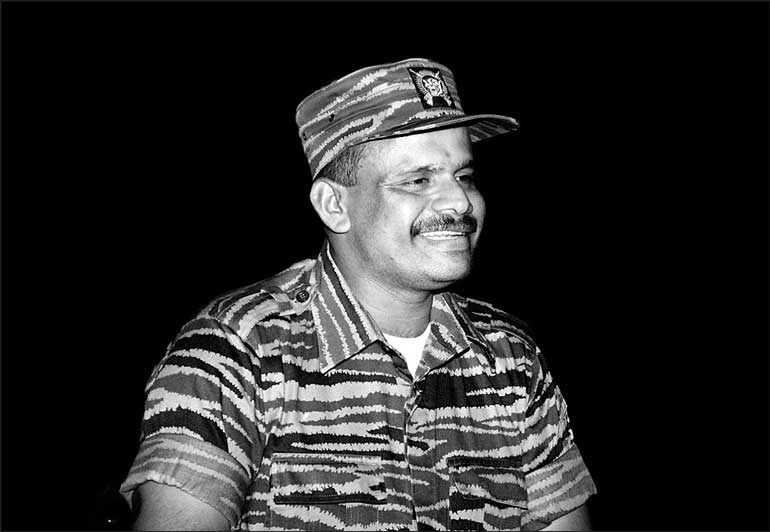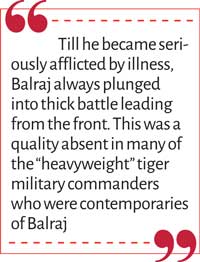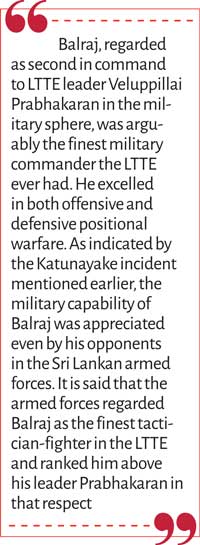Wednesday, 3 May 2023 00:20 – – 12
 Kandiah Balasegaran alias “Col” Balraj
Kandiah Balasegaran alias “Col” Balraj
 Let me begin this article by relating a little known incident that occurred in 2003. The peace process facilitated by Norway prevailed then between the Government of Sri Lanka and the Liberation Tigers of Tamil Eelam (LTTE). The LTTE Deputy Military Chief at that time was Kandiah Balasegaran alias “Col” Balraj. The legendary tiger military commander Balraj was suffering from a heart ailment and required urgent surgery in Singapore.
Let me begin this article by relating a little known incident that occurred in 2003. The peace process facilitated by Norway prevailed then between the Government of Sri Lanka and the Liberation Tigers of Tamil Eelam (LTTE). The LTTE Deputy Military Chief at that time was Kandiah Balasegaran alias “Col” Balraj. The legendary tiger military commander Balraj was suffering from a heart ailment and required urgent surgery in Singapore.
The President at that time was Chandrika Bandaranaike Kumaratunga. Ranil Wickremesinghe was the Prime Minister. Since the Oslo brokered ceasefire was then in progress, the Colombo Government allowed Balraj to be flown to Singapore via Katunayake for surgery. The ailing Balraj accompanied by Norwegian officials flew with two bodyguards to Singapore. The surgery was successful and Balraj travelled back to Sri Lanka from Singapore after a few weeks.
Upon his return, Balraj found himself “surrounded” by about 15 military officers of captain, major and Lt. Col rank at the Katunayake international airport. The Norwegian officials accompanying Balraj were perturbed as they feared that the army officers intended causing harm to Balraj. That was not so.
The army officers with field experience in the north were aware of Balraj’s military prowess and exploits. Despite being enemies on the battle front these officers had a healthy respect for Balraj whom they regarded as a first-class fighter. Knowing that Balraj was returning from Singapore these officers had gathered merely to see their tiger foe in the flesh. Some officers smiled and shook hands with Balraj. A few exchanged pleasant words. Afterwards Balraj flew safely to the Wanni by helicopter. The Norwegians were relieved that no ugly incident occurred.
The brief encounter at Katunayake demonstrated vividly the admiration with which Balraj was held by some military officers. These cheers from the “ranks of Tuscany” were due to the awesome military reputation of Balraj. The above mentioned incident illustrated the respect and regard with which Balraj was held by some officers in the Sri Lankan army then.
Balraj, regarded as second in command to LTTE leader Veluppillai Prabhakaran in the military sphere, was arguably the finest military commander the LTTE ever had. He excelled in both offensive and defensive positional warfare. As indicated by the Katunayake incident mentioned earlier, the military capability of Balraj was appreciated even by his opponents in the Sri Lankan armed forces. It is said that the armed forces regarded Balraj as the finest tactician-fighter in the LTTE and ranked him above his leader Prabhakaran in that respect.
On one occasion, the LTTE intercepted an army message from the frontline to headquarters saying that Balraj was in the field. The response was “Be careful. Balraj is more dangerous than Prabhakaran”. Later when Prabhakaran heard about this intercept, the LTTE chief was amused. He reportedly teased the shy Balraj about it saying, “The Army regards you as the No. 1 enemy now. So I am safe.”
Died on 20 May 2008
Balraj died of a heart attack at Puthukkudiyiruppu in the Mullaitheevu district on 20 May 2008. This was one year before the LTTE was militarily defeated in May 2009. Thus the LTTE deputy military chief was spared the ignominy of witnessing the military decline and fall of the tigers a year later. The 15th anniversary of his death will be commemorated later this month. This two-part article based on previous writings focuses on the life and times of Balasegaran alias Balraj.
Balraj promoted posthumously as “Brigadier” by LTTE supremo Prabhakaran earned a formidable reputation as a fearless frontline tiger commander who led from the front.
Among his many military feats, the crowning achievement was the fight he put up in 2000 at Ithaavil on the A-9 Highway that interdicted transport between the Elephant Pass garrison and the supply lines along the Kilaly-Ezhuthumadduvaal-Nagar Kovil axis for 34 days at a stretch.
It was this manoeuvre that resulted in the fall of Elephant Pass on 22 April 2000. Subsequently, in January 2009 Elephant Pass was recaptured by the Sri Lankan security forces. Balraj however was not alive then.
43-year-old Balraj’s health had deteriorated in 2007-8, making it virtually impossible for him to be at the frontlines regularly. Yet Balraj used to visit the Manal aaru/Weli-Oya battlefront as frequently as possible and supervised/coordinated the military arrangements there. Severely afflicted with coronary disease and a kidney ailment, Balraj was receiving medical attention at Puthukkudiyiruppu then. He died of a cardiac seizure at about 2 p.m. on 20 May 2008. A three-day period of mourning from 21-23 May was declared by the LTTE in 2008.
LTTE leader Prabhakaran issued a condolence message for his deputy Balraj then. In that message Prabhakaran stated, “The man who was at the centre of many of our Himalayan victories, the heroic military leader, who trained, guided and fought with our fighting formations and conventional brigades is with us no more.”
Prabhakaran went on to say of Balraj then, “His ability to move the fighting units, his focused actions and his martial characteristics struck fear in the hearts of the enemy. These same characteristics strengthened the conviction and morale of our fighters. They brought us victories.”
Liked by people and cadres
 Balraj who rose from the ranks ascended to a leadership position in the LTTE through his military skill and courage. His military exploits were legendary making him an icon for many young tigers to follow and emulate. Balraj commanded the respect and awe of LTTE cadre. While Balraj’s military valour was a source of admiration, he was also well-liked by both the people and cadres for his personal attributes.
Balraj who rose from the ranks ascended to a leadership position in the LTTE through his military skill and courage. His military exploits were legendary making him an icon for many young tigers to follow and emulate. Balraj commanded the respect and awe of LTTE cadre. While Balraj’s military valour was a source of admiration, he was also well-liked by both the people and cadres for his personal attributes.
Balraj was one of those rare leaders in the LTTE who was genuinely admired and loved by the Tamil people he associated with. He was simple, courteous and easily accessible. Balraj used to listen to the problems of the people and tried in his own way to help resolve them. In doing so he fell foul of some other senior LTTE leaders at times.
Many of the tiger leaders have been responsible for several human rights violations. But the deputy military chief was one against whom there were no serious allegations.
Balraj also incurred the wrath of other senior LTTE leaders when he voiced the concerns of ordinary people.
When the LTTE began interfering with the agriculturists of the Wanni by demanding that they sell their produce to the tigers at rock-bottom prices it was Balraj that the farmers turned to for succour.
When the LTTE took over all sea produce and began exerting a monopoly, the affected fisherfolk turned to Soosai and Balraj to register their protest and redress their grievance.
When Balraj took up these issues with Prabhakaran on behalf of the people the LTTE seniors in charge of finance and trade were offended.
Wanni population
The Wanni population during the times of LTTE domination was a blend of four types of society.
There were the original inhabitants of the Wanni; then there were the Jaffna people who had relocated gradually to the Wanni over the years; there were also the Tamils who relocated to the Wanni after 1995-96 when the LTTE was forced out of Jaffna. Fourthly there was the LTTE, their families and the families of close LTTE supporters.
There were tensions among these four different segments. When such problems occurred the ordinary people preferred to seek the help of “understanding” people like Balraj. He was like a pacifier and bridge builder.
In one glaring instance two members of Pottu Amman’s intelligence division drove their vehicle recklessly and killed a young man. The LTTE police force led by Nadesan (who later became political commissar) refused to take action. This led to enraged relatives storming the cop shop. It was Balraj who managed to douse passions by getting the tiger police to take action.
Balraj was not an orator. But he had later developed his public-speaking skills. Balraj spoke directly without fanciful flourishes and touched the hearts of his listeners.
One reason that endeared Balraj to the ordinary people was his down to earth simplicity. While most LTTE leaders moved about in Pajero vehicles with many bodyguards, Balraj moved about on foot or on a bicycle.
He used motor vehicles only for long trips and travelled about with few bodyguards.
People could easily approach him and talk. He did not keep himself aloof. Even Tamil journalists who have met him were full of praise for the man’s openness and inter-personal skills. Likewise cadre under his command loved him because of his genuine concern for them and his friendliness.
Solitary exception
Apparently many of the top LTTE leaders in later years got cut off and alienated from the people whose cause they claimed to serve. They also adopted a superior attitude towards low-rung cadre. Many of the tiger juniors were treated like servants by tiger seniors and their spouses. This too was a contributory factor towards the decay and ultimate defeat of the tigers. Balraj was perhaps a solitary exception among the senior tigers to this rule.
Adele Balasingham the Australia born wife of former LTTE ideologue and political strategist Anton Stanislaus Balasingham describes Balraj in glowing terms in her book ‘The Will to Freedom’. This is what she wrote:
“Balraj is known, loved and respected not only for his legendary military successes and undisputed and abounding courage, but also for his utter commitment and devotion to the cadres under his command. Sensitive and respectful of the sacrifice and tribulations they have endured, Balraj opts to spend as much time as possible in the camps with them.”
Born in Kokkuthoduwaai
 Kandiah Balasegaran alias Balraj was born on 27 November 1965 in the coastal area of Kokkuthoduwaai in Mullaitheevu district. He was one of the few top tiger leaders born in the northern mainland region known as the Wanni. Most tiger leaders who functioned in the Wanni were born outside the region.
Kandiah Balasegaran alias Balraj was born on 27 November 1965 in the coastal area of Kokkuthoduwaai in Mullaitheevu district. He was one of the few top tiger leaders born in the northern mainland region known as the Wanni. Most tiger leaders who functioned in the Wanni were born outside the region.
Though Balasegaran was in every sense a native son of the Wanni soil his family roots too were from the Jaffna peninsula. His ancestors hailed from Karaveddy in the Vadamaratchy division of Jaffna. Balraj’s great-grandfather had migrated to Kokkuthoduwai almost a century ago.
The family engaged in both seasonal fishing and agriculture. Balraj’s family later relocated to the Mulliyawalai-Thaniyootru area in Mullaitheevu district and engaged in agriculture.
Young Balasegaran was the fourth in a family of four boys and a girl. He was supposedly the brightest child in the family and his father Kandiah and mother Kannagi were very keen to send Balasegaran to university as he had passed his “O” Levels with flying colours. But this was not to be as the son opted to join the Tamil militant movement while doing his GCE Advanced Level.
Balasegaran had his primary education at Kokkuthoduwaai in Mullaitheevu district and secondary education at Pulmoddai in the Trincomalee district. This was because Pulmoddai was closer to Kokkuthoduwaai than Mullaitheevu. There were also some close relatives in Pulmoddai.
Kokkuthoduwaai like Kokkilai and Nayaru were places where a large number of migrant Sinhala fishermen used to come and set up “Wadiyas” during fishing season. As a youngster Balraj used to interact with these Sinhala “visitors” and learnt Sinhala well. He was also able to speak English with reasonable fluency.
Roots in the PLOTE
An interesting feature about Balraj the legendary tiger military commander is the fact that his militant roots were in the People’s Liberation Organisation of Tamil Eelam (PLOTE). What happened was this. After the original LTTE split and Umamaheswaran had formed the PLOTE “Suntharam” of Chulipuram played a big role in the new organisation until he was shot dead at Chitra press in Jaffna by the LTTE in 1982.
Suntharam had travelled the length and breadth of the North and East and formed clandestine PLOTE cells. Since the PLOTE in those days did not believe in “hit and run “tactics and was preparing for an all-out onslaught these cells were virtually “sleeper” cells.
Balasegaran was recruited by Suntharam while still a student. The youngster was impatient for some action but continued to be a member of the “dormant” PLOTE cell. Graffiti, handmade posters and distribution of leaflets were the modes of political protest undertaken by him then.
Meanwhile Lawrence and Saba of the tigers had begun LTTE work in the area and were promoting the movement. When the July 1983 anti-Tamil pogrom took place, thousands of emotional Tamil youths started joining the militant movements to get military training.
Balasegaran also wanted to do so. But there was family pressure that he continue his studies and enter university. Thus he did not join the rush to join. Events however began overtaking.
Balasegaran was in Kokkuthoduwaai for school holidays when some youths burned a CTB bus after making crew and passengers dismount at gun point. This act was the first of its kind in the area and there was a backlash. The security officials began arresting youths on a large scale.
Many were assaulted and tortured. Several youths were forced to go underground to evade arrest. Balasegaran was one of them.
Realising that a normal school life was not possible for him any longer, Balasegaran decided to join the militant movements. Wanting quick action he thought the LTTE and not the PLOTE was the best group to join. For most Tamils at that time all Tamil groups were the same. All were fighting for a common cause. But the militant groups did not feel so and treated each other as rivals. The LTTE was especially opposed to the PLOTE.
There was a school master from Jaffna named “Thaas” in the area who was in charge of recruitment for the tigers. Balasegaran approached him. Despite his PLOTE background he was selected and sent to Jaffna.
Balasegaran found himself in the hands of a tiger operative known as “Bruce” or “Kannadi”.
There was a hitch. Balasegaran’s PLOTE link made him suspect in the eyes of the LTTE.
Still the youth’s sincerity was patently visible. So the LTTE kept him but did not send him for military training in India. He was given limited local training and used as a “helper”. Officially he was not absorbed into the LTTE cadre. This was like a period of probation where his conduct was scrutinised carefully. Fate however intervened. Balaegaran was accidentally injured in a skirmish with the army though he himself was not a combatant. He was taken to India for medical treatment.
Mahendrarajah alias Mahathaya
Gopalaswamy Mahendrarajah alias Mahathaya was now the LTTE military commander for the Wanni region. Mahathaya was in Tamil Nadu for surgery when Balraj was receiving medical treatment. The “senior” Mahathaya began interacting with Balasegaran and discovered that he was from the Wanni with thorough knowledge of the Manal Aaru/Weli Oya region.
Mahathaya liked what he saw. It was Mahathaya who recognised in Balraj – from the very beginning – the rare combative skills and martial characteristics that were natural to him (Balraj).
Initially it was Mahathaya who helped Balasegaran develop as an idealistic fighter with great leadership potential. Mahathaya urged Prabhakaran then in Chennai that Balasegaran be given military training in India and recruited into LTTE ranks. Prabhakaran refused but due to Mahathaya’s persuasion, the tiger head agreed reluctantly and authorised training for Balasegaran.
This was a departure from the usual LTTE practice where those from other groups were not taken in as regulars. Though the LTTE chief was reluctant about Balraj, he later discovered the military potential in him. Prabhakaran liked the man and promoted him to unparalleled heights. He even got Balraj married to a close relative.
The fact remains however that Balraj was originally of the PLOTE and that he was a protegee of Mahathaya who was later accused of being a traitor and executed. After Balraj died in 2008, the LTTE launched a propaganda barrage praising “Brigadier Balraj” as an awesome deputy of Prabhakaran. Two salient facts were missing. One was Balraj’s PLOTE antecedents and the other his Mahathaya link.
Ninth LTTE batch
After recovering from his injuries, Balasegaran was formally inducted into the LTTE in 1984 and given military training in Tamil Nadu as part of the ninth LTTE batch. His nom de guerre in the LTTE was Balraj.
Balraj returned to the island after receiving training in Tamil Nadu and began engaging in LTTE activity. He rose up rapidly from the ranks and soon became a reputed military commander. One of Balraj’s plus points was that he led from the front. He would inspire and galvanise tiger cadre by courageously leading them up front into the thick of battle. There was no “bull shitting”.
Krishnakumar alias “Col” Kittu
In 1986, I interviewed former LTTE Jaffna district commander Sathasivampillai Krishnakumar alias “Col” Kittu for the Indian newsmagazine “Frontline”.
A pertinent point made by Kittu then was about the leadership qualities of LTTE commanders. Unlike others, Kittu said, LTTE field commanders lead from the front and did not direct operations from the rear.
Kittu observed then that tiger commanders go out front and call upon cadres to follow by shouting “Come Up! Come up!” instead of egging fighters on from behind by ordering “Go forward! Go forward!”
Leading from the front
This tiger trait identified succinctly by Kittu was something Balraj had in ample quantity. Till he became seriously afflicted by illness, Balraj always plunged into thick battle leading from the front. This was a quality absent in many of the “heavyweight” tiger military commanders who were contemporaries of Balraj.
(The writer can be reached at dbsjeyaraj@yahoo.com.)

